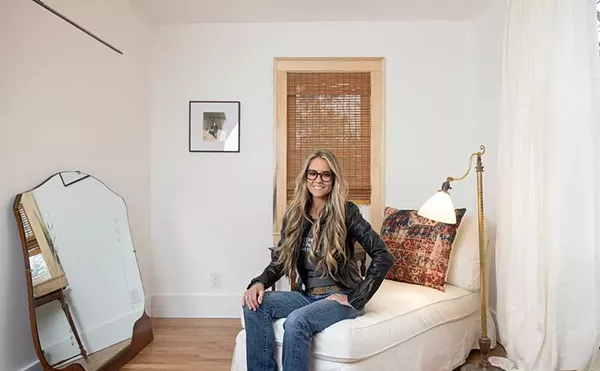
Audio By Carbonatix
[
{
"name": "GPT - Leaderboard - Inline - Content",
"component": "35519556",
"insertPoint": "5th",
"startingPoint": "3",
"requiredCountToDisplay": "3",
"maxInsertions": 100,
"adList": [
{
"adPreset": "LeaderboardInline"
}
]
}
]
Ask legendary Detroit bluesman Uncle Jessie White what he thinks about being the subject of a documentary focused on his life and music and the answer is short and sweet.
Seated on the bench of a grand piano in the Canton home of the woman who began putting the documentary together five years ago, the man with hands form-fit for ivory and a heart full of soul offers: “I feel OK about it, I hope everything works out good.”
Since 1997, the producer of Uncle Jessie White: Portrait of a Delta Blues Man, Anne Marie Graham-Hudak, has developed a special relationship with the distinguished elder statesman of Detroit blues.
The classical and popular-song piano student became enthralled with Jessie’s barrelhouse boogie style of piano playing when a friend dragged her out for a night at Hamtramck’s Attic Bar, which has spotlighted Jessie on a regular basis for about 15 years.
When she heard him, she didn’t waste time. She walked right up to the man and asked for piano lessons. The idea for the film came later when her brother-in-law, Doug Drummond, a professional film editor and the director of the documentary-in-the-works, asked her if she knew of any good subjects for a documentary.
“It is the story, as best as we can tell it, of his life,” Drummond says. “And it’s also one way to tell the story of the blues because his life is the history of the blues.”
These days, White is still giving Graham-Hudak piano lessons and the neophyte filmmaker is working to complete the 90-minute documentary, which she predicts will be finished by the end of the year.
White comes over for dinner on family occasions, and Graham-Hudak keeps herself busy shuffling her schedule between searching for funds for the movie, the demands of a pregnancy and her career as an electrical engineer.
In the past, she’s also helped untangle financial and medical matters for White.
“Anne Marie’s friendship with him on the outside is puzzling,” Blues Factory Records co-owner Mark Foreman says. “But if you get to know them, it’s beautiful. She just really decided that she wanted to help him, and she’s like that aunt who never stops giving you presents.”
Except for a final edit, the film’s in the can, but it’s been an odyssey for Graham-Hudak that took her and Drummond down to White’s birthplace, Terry, Miss., the Delta Blues Museum in Clarksdale, Miss., and the University of Mississippi campus in Jackson.
Although not included in the film, Graham-Hudak also accompanied White on his only appearance outside of the country when he starred at an April 1998 blues festival in Dresden, Germany.
Besides interviews with university blues experts and museum curators, the film includes live footage of White shot at the Attic and at an Ann Arbor recording studio.
“It’s been a long road,” says Graham-Hudak. “Jessie’s a sweet man. He’s also become a great friend. For all of us working on this, this has become a labor of love.”
Keeping White healthy for the project has been a concern for Graham-Hudak as well as for White’s family. His nine children and his grandchildren as well as Detroit’s community of blues players and fans were all pulling for him last year when he nearly died at Providence Hospital after complications related to blood clots.
White, who’ll turn 83 in September, pulled through.
“He came out of it stronger than he had been in a long time,” says Graham-Hudak. “We call him ‘cat man.’ He’s got a lot of lives.”
White’s dates at the Attic were whittled down from once a week to once or twice a month following his illness, but the nights he spends rocking the small Hamtramck blues joint are still among his favorites.
“Well, I just love to be doing something,” White says. “Just because of my age I can’t sit down and do nothing.”
It’s the life White has lived that fascinates Graham-Hudak, and the stories that he has to tell about his life as a bluesman, a former sharecropper in Terry, Miss., a gambling house worker in Jackson, Miss., a longtime employee at Detroit’s Downtown Wastepaper Company and a self-described junk man will make for a multifaceted film.
“I didn’t script it, and it takes off in a lot of directions,’ says Graham-Hudak. “It’s really three different films. It can be seen as purely educational, a film about Jessie’s life and a story of the blues. Those are all the angles we‘ve covered and we could do so much more.”
Graham-Hudak plans to market the film to libraries and to PBS, and to send it on the rounds of film festivals. So far she has received about $100,000 in funding through small grants or in-kind donations.
Like many bluesmen, some famous, some infamous and some obscure, White remembers picking cotton in Mississippi since he was able to walk and tote a sack full of cotton on his back.
“We did it from ‘kin’ to can’t,” White says. “That’s from when you ‘kin’ see to when you can’t.”
White’s occasional rumblings that the present generation has it too easy should be weighed against his experience with a foreman down South.
Once when White fell in a hole while working on a road construction crew, he heard his foreman say: “We kill a machine, we buy another one. We kill a nigger, we hire another one.”
When White reached the age of consent, he made his way to the nearby town of Jackson, before finding his way to Detroit in 1950, shortly after his parents died.
Although White made his rounds of Detroit’s blues clubs in the 1950s and 1960s, as he explains it, it wasn’t until after the 1967 riot and the closure of many of those clubs that he gained his notoriety. That’s when White’s home on 29th Street near Livernois became the mecca for Detroit blues, which it remained throughout the 1980s. It’s since been torn down.
And that’s where many contemporary Detroit blues artists, such as the Butler Twins, Johnnie Bassett, Johnny “Yard Dog” Jones and Eddie Burns, among others (including Detroit blues legend John Lee Hooker), learned, honed or displayed their trade.
White seems particularly fond of the Butler Twins: “When they came out there they couldn’t play, but they sure can play now.”
On the other hand, he seems a little disappointed with his own children, who hung around at the Friday night-until-Monday morning jam sessions, but didn’t pick up instruments.
“My kids don’t fool with it,” White says. “When I’m gone, that’s going to be the end of it.”
The 29th Street house was also the mother of other inventions, including Uncle Jessie’s signature harmonica and microphone neck brace — his “rig,” he calls it.
Detroit blues musician, historian and former host of WDET-FM 101.9’s “Blues From the Lowlands” Robert Jones describes the rig in the liner notes he penned for Uncle Jessie’s album “Uncle Jessie White and the 29th Street Blues Band,” which came out in 1991 on Blues Factory Records, as “God-awful.”
According to Jones, upon sight of the “rig made from old refrigerator parts, a lawn mower handle and who knows what else ... you get the image of a draft horse being harnessed for a hard day’s work.”
At the Attic, Uncle Jessie and his rig are obviously still alive and well, and the 29th Street Band, which on one recent Saturday night included harp blower Chuck Yokum, bassist Betty Brownlee, drummer Duke Dawson and guitarist Jeff Hoagland (filling in for regular guitarist Jeff Grand), answered their leader’s calls for songs and solos.
Peppering his original blues with covers by artists such as Jimmy Reed and Tampa Red, White occasionally wiped his brow with a handkerchief placed on the edge of his piano and demonstrated why the blues has remained so vibrant for most of a century.
Descriptions of White from some of the musicians who play with him resonate with the strong male image that Jones describes.
“He’s indestructible,” Yokum said. “He’s as indestructible as his music is. He has survived under conditions that I don’t think I would survive.”
And White’s survival as one of the paragons of Detroit blues for many years to come is ultimately what Graham-Hudak hopes to capture with the documentary.
“We want to carry on Jessie’s legacy,” explains Graham-Hudak. “He’s not as famous as John Lee Hooker, but he should be.”
To make a tax-deductible donation to help edit the final version of Uncle Jessie White: Portrait of a Delta Blues Man, please send a check or money order to Uncle Jessie White Documentary/Detroit Blues Society, c/o 1432 Ledgewood Drive, Canton, MI 48188.
Mike Murphy is a Detroit-area freelance writer. E-mail letters@metrotimes.com



